SNCF
 | |
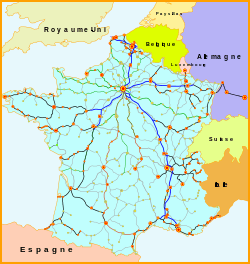 Map of the French railways on which "TGV" or "Intercités" SNCF trains run. Only lines going to / from Paris are shown here. | |
|
TGV Atlantique - french high-speed train. | |
| Reporting mark | TGV, Intercités, TER, Transilien, Ouigo, Eurostar, Thalys, TGV Lyria |
|---|---|
| Locale | France |
| Dates of operation | 1938–present |
| Predecessor |
Compagnie des chemins de fer du Nord Administration des chemins de fer d'Alsace et de Lorraine Compagnie des chemins de fer de Paris à Lyon et à la Méditerranée Compagnie du chemin de fer de Paris à Orléans Compagnie des chemins de fer du Midi et du Canal latéral à la Garonne Compagnie des chemins de fer de l'Est Administration des chemins de fer de l'État |
| Track gauge | 1,435 mm (4 ft 8 1⁄2 in) and 1,000 mm (3 ft 3 3⁄8 in) |
| Length | 29,273 km (18,189 mi) |
| Headquarters | Saint-Denis, Seine-Saint-Denis |
| Website | www.sncf.com |
| state-owned | |
| Industry | rail transport |
| Founded | 1938 |
| Headquarters | France |
Key people | Guillaume Pepy (President) |
Number of employees | 149,500 (2015) |
| Subsidiaries |
SNCF Mobilités SNCF Réseau |
| Website |
www |
SNCF (Société nationale des chemins de fer français; "National society of French railways" or "French National Railway Company") is France's national state-owned railway company and manages the rail traffic in France and the Principality of Monaco. SNCF operates the country's national rail services, including the TGV, France's high-speed rail network. Its functions include operation of railway services for passengers and freight, and maintenance and signalling of rail infrastructure.
SNCF employs more than 180,000 people in 120 countries around the globe. The railway network consists of about 32,000 km (20,000 mi) of route, of which 1,800 km (1,100 mi) are high-speed lines and 14,500 km (9,000 mi) electrified. About 14,000 trains are operated daily. The company has its headquarters in the 14th arrondissement of Paris, in the Rue du Commandant Mouchotte.[1]
In 2010 SNCF was ranked 22nd in France and 214th globally on the Fortune Global 500 list.[2]
It is the main business of the SNCF group, which in 2014 employed 245,763 people and had €27.2 billion of sales in 120 countries.[3] The chairman of the SNCF group is Guillaume Pépy.
Business scope

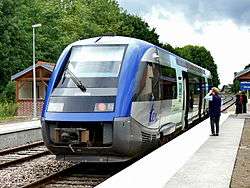
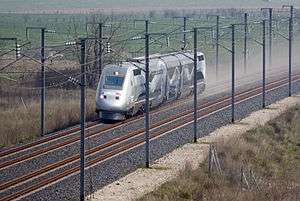
High-speed rail
SNCF operates almost all of France's railway system, including the TGV (Train à Grande Vitesse, meaning "High-Speed Train"), In the 1970s, SNCF began the TGV high-speed train programme with the intention of creating the world's fastest railway network. It came to fruition in 1981, when the first TGV service, from Paris to Lyon, was inaugurated. Today, SNCF operates 1,850 km (about 1,150 miles) of designated high-speed track that accommodate more than 800 high-speed services per day. SNCF’s TGV trains carry more than 100 million passengers a year. TGV lines and TGV technology are now spread across several European countries in addition to South Korea.
SNCF's TGV has set many world speed records, the most recent on 3 April 2007, when a new version of the TGV dubbed the V150 with larger wheels than the usual TGV, was able to cover more ground with each rotation and had a stronger 25,000 hp (18,600 kW) engine, and broke the world speed record for conventional railway trains, reaching 574.8 km/h (357.2 mph).
SNCF has a remarkable safety record. After nearly 30 years in operation, SNCF’s TGV system has only experienced one fatal accident.
SNCF also owns the tracks and the stations.
SNCF operations
Since the 1990s, SNCF has been selling railway carriages to regional governments, with the creation of the Train Express Régional brand. SNCF also maintains a broad scope of international business that includes work on freight lines, inter-city lines and commuter lines. SNCF experts provide logistics, design, construction, operations and maintenance services. SNCF operates the international ticketing agency, Voyages SNCF (formerly Rail Europe).
SNCF has employees in 120 countries offering extensive overseas and cross border consulting. Those projects include:
- Israel: Assistance and Training. SNCF International provides assistance to Israel Railways in every area of rail operations including projects to upgrade the network's general safety regulations. Other assistance and training programmes involve Infrastructure and the Traction Division.
- Taiwan: Operations Training. SNCF supervised the prime contractor responsible for construction of the Taiwan Railways Administration’s main high-speed rail line. It also trained rail traffic controllers, drivers, and crew members. On behalf of the Government of Taiwan, SNCF managed the high-speed railway Command Control Centre.
- United Kingdom: Maintenance. In 2007-2008, SNCF-International consultants audited the maintenance practices applied to the track, signalling and overhead electric power line on British high-speed rail lines connecting London to the Channel Tunnel. In addition, it conducted an audit of the maintainer’s performance from the service quality and cost control standpoint, made recommendations for improvements, and proposed a three-year Business Plan.
- South Korea: HSR Electrification Design. SNCF advised Korean Railroads on the electrification of tracks between Daegu and Busan and on linking existing conventional tracks to the new high-speed line. SNCF also assisted in selecting and inspecting high-speed rolling stock and trained 400 senior manager, engineers, and executives in a broad range of skills, including signalling, catenaries, track, rolling stock maintenance, HSR operation, safety management, marketing, and passenger information systems. Until the end of 2009, SNCF assisted Korea in maintaining its high-speed.
- Spain: Signalling System. SNCF partnered with ADIF (Spanish railway infrastructure provider) in the study, supply, installation, and maintenance of the standard EU railway signaling system along the Madrid-Lleida high-speed line. On behalf of the Spanish Government, SNCF designed and led maintenance operations on this line over a two-year period.
- France: Lead Infrastructure and Rolling Stock Maintainer – The scope of SNCF’s maintenance duties is staggering: it maintains 32,000 km (20,000 mi) of track, 26,500 main sets of points and crossings, 2,300 signal boxes, 80,000 track circuits, over 1 million relays, etc. It also maintains 3,900 locomotives and 500 high-speed trains. Each of SNCF’s TGV trains travels more than 39,000 km (24,000 mi) a month – enough to circle the globe. Each year SNCF’s Human Resources Department provides over 1.2 million hours of training to its over 25,000 employees.
History
SNCF was formed in 1938 with the nationalisation of France's main railway companies (Chemin de fer, literally, 'path of iron', means railway). These were the:
- Chemins de fer de l'Est (Est) (Eastern Railways)
- Chemins de fer de l'État (État) (State Railways) (merged in 1908 with the Chemins de fer de l'Ouest)
- Chemins de fer du Nord (Nord) (Northern Railways)
- Chemins de fer de Paris à Lyon et à la Méditerranée (PLM) (Paris, Lyon and Mediterranean Railways)
- Chemins de fer de Paris à Orléans et du Midi (Paris, Orléans, and Southern Railways) (PO-Midi, formed in 1934 from the merger of the Chemin de fer de Paris à Orléans and the Chemins de fer du Midi)
- Administration des chemins de fer d'Alsace et de Lorraine (AL) (Alsace-Lorraine Railways)
- Syndicats du Chemin de fer de Grande Ceinture et de Petite Ceinture (Great and Little Belt Railways)
The French state originally took 51% ownership of SNCF and invested large amounts of public subsidies into the system. Today, SNCF is wholly owned by the French state.
World War II
Following the 1940 Armistice and until August 1944, SNCF was requisitioned for the transport of German armed forces and armaments. The invading German troops were responsible for the destruction of nearly 350 French railway bridges and tunnels. According to differing estimates, SNCF surrendered between 125,000-213,000 wagons and 1,000-2,000 locomotives.[4][5]
France's railway infrastructure and rolling stocks were a target for the French Resistance aimed at disrupting and fighting the German occupying forces.[6][7] This allowed SNCF employees to perform many acts of resistance,[8] including the formation of the Résistance-Fer movement in 1943. Nearly 1,700 SNCF railway workers were killed or deported for resisting Nazi orders.[9][10] 150 Résistance-Fer agents were shot for their acts of resistance, 500 of them were deported. Half of those deported died in concentration camps.[11]
German occupying forces in France also requisitioned SNCF to transport nearly 77,000 Jews and other Holocaust victims to Nazi extermination camps.[12][13] These deportations have been the subject of historical controversy and lawsuits (such as the Lipietz case) in France as well as in the United States (where subsidiary Keolis is a transportation contractor) to the present day.[10][14]
In 1992 SNCF commissioned French academics to write a history of SNCF activities during World War II. The resultant report was published in 1996.[15][16]
More recently, some sources have claimed that SNCF billed Nazi-occupied France for third-class tickets for Holocaust victims transported to extermination camps,[17][18] although passengers were transported in cattle cars.[19] Other sources have reported that after the liberation of France SNCF continued to seek payment for transporting Holocaust victims to Germany.[17][20] However, historian Michael Marrus has written that claims that SNCF billed for third-class tickets and continued to seek payment after the war ended were made as part of a legal case brought against SNCF, and did not match with historians' understanding of what happened. Marrus argues that SNCF had no margin of maneuver during the German occupation and that the actions of SNCF employees were not ideologically motivated.[13] According to Serge Klarsfeld, president of the organization Sons and Daughters of Jewish Deportees from France, SNCF was forced by German and Vichy authorities to cooperate in providing transport for French Jews to the border and did not make any profit from this transport.[21]
In December 2014, SNCF agreed to pay up to $60 million worth of compensation to Holocaust survivors in the United States.[22] It corresponds to approximately $100,000 per survivor.[23]
On 1 January 2015, Réseau ferré de France (RFF) merged with SNCF Infra and the Direction de la circulation ferroviaire (DCF) and became SNCF Réseau, the operational assets of SNCF became SNCF Mobilités, and both groups were placed under the control of SNCF.
Design
The industrial designer Paul Arzens styled many of SNCF's locomotives from the 1940s until the 1970s. A particularly distinctive type is the "broken nose" style of electric and diesel locomotives.
Current day
SNCF is recognised as a leader in eco-mobility with a commitment to become the world’s first operator to offer carbon neutral travel at no extra cost to travellers. SNCF has cut emissions on its cross-channel Paris to London route by 31% in two years by using more electricity from non-fossil fuel sources. SNCF's 39 manufacturing facilities are in the process of “going green” and 9 sites are already ISO 14000 certified. SNCF developed an interactive website to help travellers calculate the environmental impact of their travel choices.
In May 2014, the company had discovered that 2,000 new trains they ordered at a cost of 15 billion euros are too wide for many of France's regional platforms, Construction work has already started to reconfigure them.[24]
Codeshare with airlines
SNCF codeshares with Air Austral, Air France, Air Tahiti Nui, American Airlines, Cathay Pacific, Middle East Airlines, Etihad Airways, Qatar Airways, and SriLankan Airlines. In exchange, SNCF allows passengers on these flights to book railway services between Charles de Gaulle Airport in Roissy (near Paris) and Aix-en-Provence, Angers, Avignon, Bordeaux, Le Mans, Lille, Lyon Part-Dieu, Marseille, Montpellier, Nantes, Nîmes, Poiters, Rennes, Strasbourg, Tours, and Valence with their airline. The IATA designator used by airlines in connection with these journeys is 2C.
Continental Airlines discontinued its codeshare with SNCF on 15 August 2010.[25]
Company structure and subsidiaries
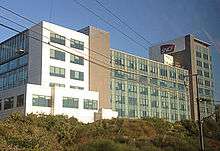
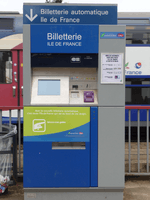
Headquarters
Since July 2013, SNCF headquarters are located in the Parisian suburb of Saint-Denis at 2, place aux Étoiles, 93200 Saint Denis.[26] The move, motivated by cutting operating costs by 10 million euros per year,[27] is historically significant: for the first time in the history of SNCF their headquarters is no longer located within the city limits of Paris.
From 1999 to 2013, SNCF's headquarters were located in the Montparnasse neighborhood of the 14th arrondissement of Paris,[1] located near the Gare Montparnasse.[28]
Prior to 1999, SNCF's historic headquarters was located at 88 Rue Saint-Lazare in the 9th arrondissement.[28][29] In 1996 the chairman of SNCF, Louis Gallois, announced that SNCF would move its headquarters to a new location during the middle of 1997.[30]
Divisions
Since 1 January 2015 SNCF consists of five divisions:
- SNCF Réseau is the infrastructure division of SNCF, and carries out track and other infrastructure maintenance, design and construction. Subsidiaries in the group include Systra, Inexia and SNCF International.
- SNCF Voyageurs is responsible for passenger transport. Constituent parts include TGV, TER, Transilien and Intercités (formerly Corail Intercités, Lunéa and Téoz).
- SNCF Keolis is responsible for urban transport (tramways, bus networks).
- SNCF Logistics is the rail and general freight logistics section of SNCF, including Fret SNCF, VFLI and other European rail freight companies (since 2010 collected under the brand Captrain[31]), as well as rail-freight stock management companies including France Wagons and Ermewa.
- SNCF Immobilier.
Shareholdings
SNCF has full or partial shares in a large number of companies, the majority of which are rail or transport related. These include:[32]
- Geodis (100%)
- ERMEWA (100%)
- France Wagons (100%)
- SGW : Société de Gérance de Wagons (67.5%)
- CTC : Compagnie des Transports Céréaliers (69.36%)
- SEGI (98.96%)
- Naviland Cargo (94.37%) previously CNC Transports, Compagnie Nouvelle de Conteneurs.
General freight transport:
- C-Modalohr Express (51%)
- Novatrans (38.25%)
- Districhrono (100%)
- Ecorail (99.9%)
- Froidcombi (48.93%)
- Rouch Intermodal (98.96%)
- Sefergie (98.96%)
- EFFIA (99.99%)
Passenger transport
- Thalys International (70%)
- Eurostar International (55%)[33]
- Lyria (74 %)
- Elipsos International (50%)
- Artésia (50%)
- SeaFrance (100 %) Sold to Eurotunnel.
- Rhealys SA (30%)
- Keolis (70%)[34]
- Govia (24.5%)[35]
- iDTGV (100%)
- Ouigo (100%)
- Nuovo Trasporto Viaggiatori (20%)[36]
Tickets
- Voyages-sncf.com (50.1%), the on-line travel agency of SNCF
- Rail Europe, Inc. (50%) Bought from British Rail.
- GLe-trade
Consulting
- AREP (99.99%)
- SNCF International (100%)
- Inexia
- Systra (35.87 %): engineering for public transport
Housing
- ICF Habitat Novedis (100%): rental housing (social and private housing)
See also
- History of rail transport in France
- List of French companies
- List of SNCF locomotive and multiple-unit classes
- Transport express régional
- Corail (train)
- Transport in France
- List of SNCF stations
- Autorité de Régulation des Activités Ferroviaires
References
- 1 2 "Legal information." SNCF. Retrieved on 24 October 2013.
- ↑ "Global 500 2010: Countries". CNN. Retrieved 24 October 2013.
- ↑ http://www.sncf.com/ressources/reports/sncf_2014_financial_report_0.pdf
- ↑ Jones, Joseph (1984). The Politics of Transport in Twentieth-Century France. McGill Queens University Press. pp. 115–116. ISBN 0773504281. Retrieved 1 November 2012.
- ↑ Mierzejewski (2000). The Most Valuable Asset of the Reich: A History of the German National Railway Volume 2, 1933-1945. The university of North Carolina Press. p. 84. ISBN 0807825743. Retrieved 1 November 2012.
- ↑ Ribeill, Georges (2002–2003). "Obstétrique de guerre: Le cas de la SNCF (1939-1945)" (PDF). Les Cahiers de Recits, Laboratoire de Recherche sur les Choix Industriels, Technologiques et Scientifiques (in French). Belfort-Montbéliard: Université de Technologie Belfort-Montbéliard. 2: 49–61. Retrieved 9 January 2012.
- ↑ Christofferson, Thomas; Christofferson, Michael (2006). France during World War II: From Defeat to Liberation. New York: Fordham University Press. ISBN 978-0-8232-2563-7.
- ↑ Durand, Paul (1968). La SNCF pendant la guerre, sa résistance à l'occupant. Paris: Presses Universitaires de France.
- ↑ Lombard, Marie-Amélie (25 January 2011). "Shoah : les "regrets" de la SNCF". Le Figaro. France. Retrieved 31 January 2010.
- 1 2 Baume, Maïa De La (25 January 2011). "French Railway Formally Apologizes to Holocaust Victims". The New York Times. ISSN 0362-4331. Retrieved 26 October 2012.
- ↑ Ribeill, Georges (2006). "Résistance-Fer, du " réseau " à l'association". Revue d’histoire des chemins de fer. 34: 53–73. Retrieved 8 January 2012.
- ↑ Shaver, Katherine (7 July 2010). "Holocaust group faults VRE contract". The Washington Post. ISSN 0740-5421. Retrieved 7 July 2010.
- 1 2 Marrus, Michael R. (2011). "Chapter 12 The Case of the French Railways and the Deportation of Jews in 1944". In Bankier, David; Michman, Dan. Holocaust and Justice. Berghahn Books. ISBN 978-9-65308-353-0.
- ↑ CBC News (7 June 2006). "French railway must pay for transporting family to Nazis". Retrieved 9 June 2006.
- ↑ "Facilitating historical research". SNCF.
- ↑ Associated Press (20 May 2011). "U.S. bill requires French rail company to disclose 'truth' of its Holocaust role". Haaretz. Retrieved 28 September 2012.
- 1 2 Chrisafis, Angelique (7 June 2006). "French state and SNCF guilty of collusion in deporting Jews". The Guardian. London.
- ↑ "French railways win WWII appeal". BBC News. 27 March 2007. Retrieved 7 November 2013.
- ↑ "SNCF airs Holocaust regret as it bids for Florida rail | News | The Week UK". Thefirstpost.co.uk. 15 November 2010.
- ↑ Riding, Alan (20 March 2003). "Nazis' Human Cargo Now Haunts French Railway". The New York Times. Retrieved 7 November 2013.
- ↑ Serge Klarsfeld (26 June 2012). "Analysis of Statements Made During the June 20, 2012 Hearing of the U.S. Senate Committee of the Judiciary" (PDF). Memorial de la Shoah. Retrieved 19 November 2013.
- ↑ France to compensate American Holocaust survivors
- ↑ Le Monde, Pour le rôle de la SNCF dans la Shoah, Paris va verser 100 000 euros à chaque déporté américain
- ↑ "French red faces over trains that are 'too wide'". BBC News. 21 May 2014.
- ↑ "United Airlines - Airline Tickets, Vacations Packages, Travel Deals, and Company Information on united.com". Continental.com. Archived from the original on 4 December 2010.
- ↑ "Legal notice." SNCF. Retrieved on 12 January 2015. "Siège : 2 place aux Etoiles, 93200 Saint Denis"
- ↑ Bertrand, Philippe. "La SNCF prend ses nouveaux quartiers à Saint-Denis" (Archive). Les Echos. 29 July 2013.
- 1 2 "Le siège haut perché de la SNCF à Montparnasse" (Archive). Les Echos. 20 May 1999. Page 54. Retrieved on 1 May 2010. "Pari tenu : réceptionné le 19 mars par Bouygues Immobilier et livré à son occupant dix jours plus tard, le nouveau siège de la SNCF est sorti de la gangue du grand ensemble de la gare Montparnasse, dans le 14e arrondissement de Paris, en quinze mois d'un chantier intense qui a mobilisé sur place jusqu'à 650 personnes. Quelque 800 postes de travail sont concernés sur les 2.500 qui gravitaient hier autour du siège historique de Saint-Lazare (9e arrondissement), consacrant la partition entre une direction générale resserrée et des services centraux pléthoriques."
- ↑ "Welcome to the SNCF server!" (Archive). SNCF. 3 June 1997. Retrieved on 28 April 2010. "88, Rue St Lazare 75009 PARIS."
- ↑ "La SNCF veut délocaliser son siège parisien" (Archive). L'Humanité. 23 September 1996. Retrieved on 28 April 2010.
- ↑ Captrain brand to consolidate international freight operations 12 February 2010 , www.railwaygazette.com
- ↑ "Rapport Financier" (PDF) (in French). Retrieved 1 September 2008.
- ↑ "Eurostar Ownership & Structure". Eurostar.
- ↑ SNCF increases its shareholding in Keolis to accelerate the next phase of the company's development Keolis April 2012
- ↑ Govia awarded TSGN franchise Govia 23 May 2014
- ↑ Pepy takes a stake in NTV 10 October 2008 , www.railwaygazette.com
External links
| Wikimedia Commons has media related to SNCF. |
- Official website
- Map
- History of SNCF (French)
- Bachelier Report on WWII activities (English)
- SNCF Society - enthusiasts' site (English) (French)
- Ultimate Guide to navigating the French railroad system